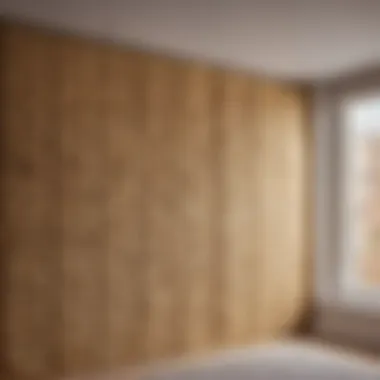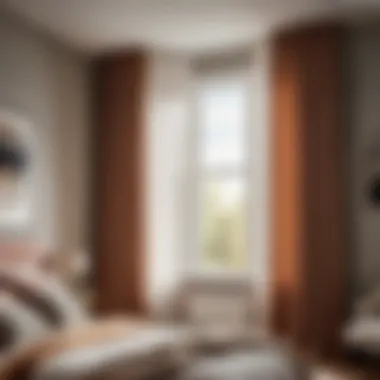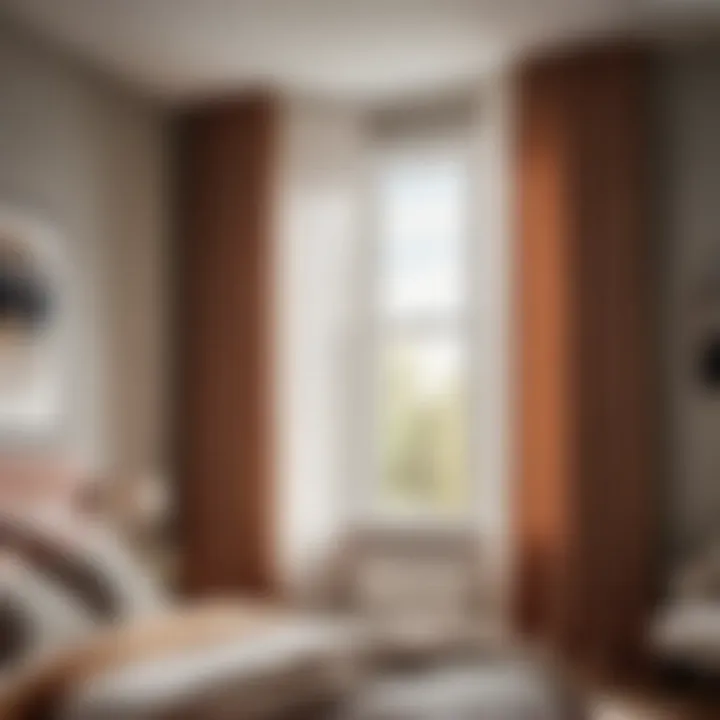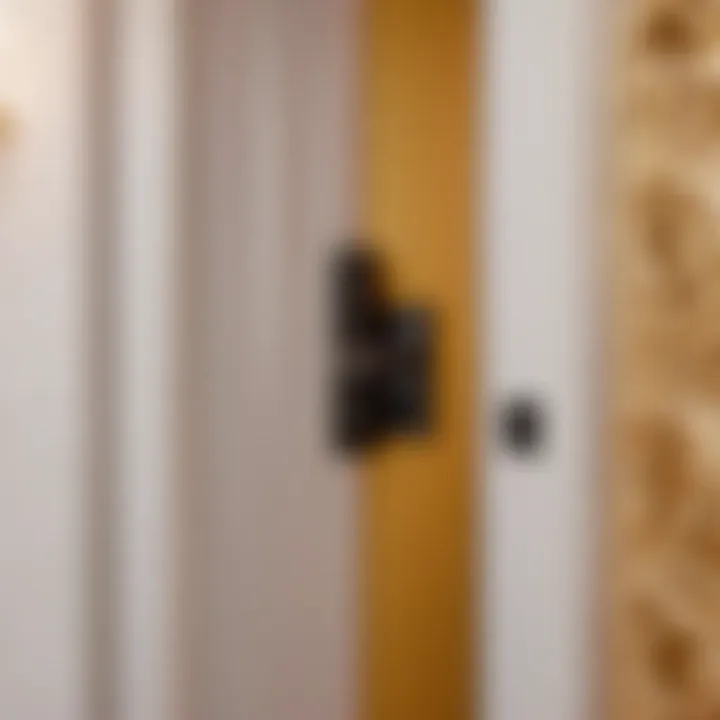Mastering the Art of Soundproofing Your Bedroom in an Apartment: A Detailed Guide


Materials:
- Soundproof curtains: 2 panels measuring 52"x84"
- Acoustic foam panels: 12 pieces of 12"x12"
- Mass loaded vinyl (MLV): 1 roll of 4.5'x10'
- Green Glue sealant: 1 tube
- Door sweep: 1 piece
- Weatherstripping tape: 1 roll
- Acoustic caulk: 1 tube
DIY Steps:
- Installing Soundproof Curtains:
- Applying Acoustic Foam Panels:
- Using Mass Loaded Vinyl (MLV):
- Sealing Doors with Green Glue:
- Weatherstripping Windows:
- Caulking Wall Gaps with Acoustic Caulk:
- Measure the window dimensions and hang the curtains securely to cover the entire area, ensuring they touch the floor for maximum noise absorption.
- Place the foam panels strategically on walls to dampen sound vibrations. Use adhesive putty for easy application.
- Cut the MLV to fit wall dimensions and affix it directly to the walls using a strong adhesive.
- Apply Green Glue sealant around the door edges and attach the door sweep to the bottom to prevent sound leakage.
- Apply weatherstripping tape around window frames to eliminate gaps that allow noise to enter.
- Fill any gaps or cracks in walls with acoustic caulk to prevent sound penetration.
Technical Aspects:
- Tools Required: Measuring tape, drill, screws, adhesive putty, caulking gun
- Timing Specifics: Set aside a weekend for this project to ensure thorough installation
- Critical Techniques: Proper measurement and precise application are essential for maximum soundproofing effectiveness.
DIY Project Process:
- Start by Installing Soundproof Curtains:
- Proceed to Apply Acoustic Foam Panels:
- Continue with Mass Loaded Vinyl Installation:
- Seal Doors and Windows:
- Caulk Wall Cracks:
- Secure curtain rods and attach the curtains, ensuring they are tightly fit to prevent noise leakage.
- Place the foam panels in a checkerboard pattern on the walls to disrupt sound waves effectively.
- Cut the MLV to size and apply it with pressure to create a barrier against sound transmission.
- Use Green Glue on doors and weatherstripping on windows to complete the soundproofing setup.
- Fill any gaps with acoustic caulk, ensuring a seamless finish for optimal sound insulation.
Troubleshooting Tips:


- If experiencing sound leaks, check for gaps around doors and windows. Seal any openings with additional caulk or weatherstripping.
- For inadequate noise reduction, consider layering additional materials or consulting a professional for further recommendations.
Introduction
In the hustle and bustle of modern living, finding peace and tranquility within the confines of your apartment can be challenging. The importance of soundproofing a bedroom cannot be overstated, especially in high-density living situations where noise from neighbors or the surrounding environment can disrupt your much-needed rest and relaxation. This article serves as a comprehensive guide to help you transform your bedroom into a serene sanctuary where you can unwind without the interference of external disturbances.
Understanding the Importance of Soundproofing
Soundproofing plays a vital role in ensuring a comfortable and peaceful living environment. By effectively soundproofing your bedroom, you can mitigate noise disturbances, allowing you to enjoy restful sleep and improved concentration. Soundproofing also enhances privacy, preventing sound from traveling in and out of your space, thus creating a sense of seclusion within your apartment.
Factors Affecting Noise Transmission in Apartments
Noise transmission in apartments can be influenced by various factors, including the construction materials used, layout of the building, and proximity to sources of noise such as traffic or neighbors. Understanding these factors is crucial in determining the most effective soundproofing solutions for your bedroom. Additionally, identifying the primary sources of noise can help you strategize and prioritize soundproofing efforts to achieve optimal results.
Assessment and Planning
In the realm of soundproofing a bedroom in an apartment, Assessment and Planning play a pivotal role in ensuring the success of the project. Before embarking on any soundproofing endeavors, it is crucial to have a clear understanding of the existing noise sources and transmission paths within the living space. By conducting a thorough assessment, one can pinpoint the specific areas that require attention and devise an effective plan to address them.
Assessment involves identifying the primary sources of noise infiltration, which could range from external street noise to internal disturbances such as appliances, footsteps, or voices. Additionally, factors like room layout, building materials, and neighboring units can significantly impact the extent of sound transfer. By taking stock of these elements, individuals can develop a comprehensive strategy tailored to their unique living conditions.
Furthermore, Planning is essential in setting realistic soundproofing goals and establishing a feasible budget for the project. Setting clear objectives enables individuals to prioritize their soundproofing efforts, focusing on areas that yield the most significant noise reduction benefits. Simultaneously, creating a detailed budget helps in managing expenses efficiently and allocating resources effectively.
Effective Planning also involves outlining a step-by-step roadmap for implementing soundproofing measures. From selecting the right materials to determining the most suitable techniques, a well-thought-out plan paves the way for a seamless soundproofing process. Overall, Assessment and Planning lay the foundation for a successful soundproofing project, ensuring that efforts are targeted, resources are optimized, and outcomes align with the desired noise reduction outcomes.
Identifying Noise Sources in Your Bedroom
Before commencing any soundproofing endeavors, it is essential to identify the primary sources of noise within the bedroom. Common sources may include traffic noise, neighbors, household appliances, plumbing, or structural vibrations. By pinpointing these sources, individuals can tailor their soundproofing solutions to address the specific noise challenges they face.
Assessing noise sources may involve conducting sound tests at different times of the day to track variations in noise levels, as well as inspecting the room for potential sound leakage points such as windows, doors, or wall penetrations. By thoroughly understanding the sources of noise, individuals can develop targeted soundproofing strategies that effectively mitigate disturbances and enhance overall acoustic comfort within the bedroom.
Setting Soundproofing Goals and Budget
Setting soundproofing goals is a crucial step in the planning process, as it helps individuals define the desired level of noise reduction they wish to achieve. Whether aiming to create a near-silent environment or simply reduce ambient noise to a comfortable level, establishing clear objectives guides the selection of appropriate soundproofing materials and techniques.
Simultaneously, developing a soundproofing budget ensures that financial resources are allocated wisely to meet the project's requirements. By estimating the costs of materials, labor, and professional services, individuals can avoid overspending and strategically invest in soundproofing solutions that deliver optimal acoustic benefits within budget constraints.
Creating a Soundproofing Plan
Creating a soundproofing plan involves detailing the specific steps and methods that will be utilized to reduce noise transmission in the bedroom. This includes selecting suitable soundproofing materials such as acoustic panels, mass-loaded vinyl, or soundproof curtains, based on their acoustic performance and installation ease.


Moreover, a soundproofing plan outlines the sequence of tasks to be undertaken, from sealing gaps and cracks to enhancing insulation and implementing barrier solutions. By organizing these tasks cohesively, individuals can ensure a systematic approach to soundproofing that addresses all potential noise entry points and minimizes sound disturbances effectively.
DIY Soundproofing Techniques
In the realm of soundproofing a bedroom in an apartment, the utilization of DIY techniques holds significant importance. DIY soundproofing techniques offer an accessible and cost-effective approach to reducing noise disturbances within your living space. In this article, delving into the specifics of DIY soundproofing techniques not only empowers individuals with practical skills but also provides valuable insights into enhancing overall acoustic quality at home. By exploring various DIY methods, readers can gain a deeper understanding of how to address noise issues in their apartments efficiently.
Sealing Gaps and Cracks
Sealing gaps and cracks in walls, windows, and doors is a fundamental DIY soundproofing technique that plays a pivotal role in minimizing sound transmission. The presence of gaps and cracks allows noise to seep through easily, disrupting the peaceful ambiance of your bedroom. By meticulously inspecting and sealing these openings using acoustic sealants or weatherstripping materials, you can create a more airtight environment that effectively blocks out external noises. Additionally, sealing gaps and cracks not only enhances soundproofing but also contributes to improving energy efficiency by preventing heat loss or drafts.
Installing Heavy Curtains
When it comes to DIY soundproofing, installing heavy curtains offers a practical solution to dampen sound vibrations and reduce external noise infiltration. Heavy curtains with multiple layers or added backing materials such as noise-reducing fabric can act as a barrier that absorbs and blocks sound waves. By strategically placing these curtains over windows and doors, you can create a sound-absorbing barrier that enhances the overall acoustics of your bedroom. Moreover, heavy curtains also provide privacy, light control, and thermal insulation benefits, making them a versatile addition to your living space.
Adding Rugs and Carpets
Incorporating rugs and carpets into your bedroom decor not only adds aesthetic appeal but also contributes to soundproofing efforts. The soft, dense textures of rugs and carpets help to absorb impact noise generated from footsteps, furniture movement, or other activities, reducing overall sound transmission. By placing rugs strategically on hard flooring surfaces or beneath furniture, you can create a sound-absorbing layer that minimizes echoing and reverberation in the room. Additionally, rugs and carpets add warmth, comfort, and a touch of luxury to your living space, enhancing both visual and acoustic aspects of your bedroom.
Advanced Soundproofing Solutions
In the realm of soundproofing techniques for apartments, advanced solutions play a crucial role in achieving optimal acoustic isolation and creating a serene living space. Emphasizing the importance of advanced soundproofing solutions within this extensive guide underscores the significance of taking measures beyond basic DIY methods. By delving into the domain of advanced soundproofing, individuals can address superior levels of noise intrusion and enhance their overall quality of life.
Soundproofing Walls with Mass Loaded Vinyl
Soundproofing walls with mass loaded vinyl stands as a highly effective method to significantly reduce sound transmission within an apartment setting. Mass loaded vinyl, known for its dense composition, acts as a barrier to block airborne noises such as loud voices, music, or traffic sounds from penetrating through walls. The installation of mass loaded vinyl involves applying this specialized soundproofing material directly onto existing walls, thereby enhancing the sound insulation properties of the room. With its ability to dampen sound vibrations and minimize noise propagation, mass loaded vinyl serves as a formidable solution for creating a quieter indoor environment. The benefits of this technique extend to improving privacy levels, enhancing concentration, and fostering a peaceful ambiance within the bedroom.
Installing Acoustic Panels or Foam
The integration of acoustic panels or foam in a soundproofing strategy plays a pivotal role in absorbing and diffusing sound waves to reduce reverberations and echoes within a room. Acoustic panels are designed to mitigate sound reflections and enhance sound clarity by absorbing excess noise energy. Similarly, acoustic foam, with its porous structure, effectively diminishes high-frequency noises and optimizes the room's acoustic performance. When strategically placed on walls or ceilings, acoustic panels and foam contribute to creating a more acoustically balanced environment, conducive to unwinding and relaxation. Incorporating these sound-absorbing elements into the soundproofing plan elevates the soundproofing effectiveness and augments the overall comfort and tranquility of the bedroom space.
Upgrading Doors and Windows for Better Soundproofing
Upgrading doors and windows with soundproofing enhancements represents a fundamental step in fortifying a bedroom against external noise intrusion. By replacing standard doors with solid-core options or utilizing specialized door sweeps and seals, one can minimize sound leakage and bolster the room's overall sound insulation. Equally essential is upgrading windows with double or triple panes, which offer superior sound reduction properties compared to single-pane windows. Additionally, installing weather stripping around window frames and using heavy curtains further enhances the soundproofing capabilities of windows. Improving the soundproofing efficiency of doors and windows not only reduces external noise disturbances but also fosters a quieter and more tranquil indoor environment, promoting restful sleep and enhanced well-being.
Professional Soundproofing Services
Professional soundproofing services play a crucial role in ensuring the effective sound insulation of your bedroom in an apartment. These services offer specialized expertise and advanced solutions to address noise issues comprehensively, catering to the specific needs of individual spaces.
Consulting with Soundproofing Experts


When considering professional soundproofing services, consulting with soundproofing experts is a pivotal first step. These specialists possess in-depth knowledge about sound transmission, building acoustics, and the latest soundproofing technologies. By engaging with experts, you can benefit from a personalized assessment of your bedroom's soundproofing requirements. Soundproofing consultants will evaluate the existing noise sources, assess the structural vulnerabilities contributing to noise transmission, and recommend tailored solutions to enhance the acoustics of your space.
Hiring Soundproofing Contractors
Hiring soundproofing contractors is a strategic decision that ensures the successful implementation of soundproofing solutions in your bedroom. These professionals have the necessary skills and experience to execute soundproofing projects with precision and efficiency. When hiring contractors, it is essential to verify their credentials, reputation, and portfolio of completed projects. Prioritize contractors with expertise in residential soundproofing to guarantee optimal results for your apartment bedroom. Collaborating with skilled contractors will streamline the soundproofing process, from planning to installation, resulting in a well-protected and acoustically improved living environment.
Maintaining Soundproofing Measures
In the realm of soundproofing an apartment bedroom, the topic of maintaining soundproofing measures holds a vital role in sustaining the effectiveness of your chosen soundproofing solutions. It is not merely about implementing soundproofing once and forgetting about it; regular maintenance is key to ensuring optimal noise reduction over time. By delving into how to effectively uphold soundproofing measures, you can extend the longevity and efficiency of your soundproofing endeavors.
When considering the specific elements of maintaining soundproofing measures, it is crucial to emphasize the importance of regular inspections and repairs. Conducting regular inspections allows you to identify any wear and tear on your soundproofing installations promptly. By addressing these issues early on, you can prevent potential sound leakages and ensure that your soundproofing remains effective in reducing noise disturbances. Moreover, undertaking timely repairs to any damaged or deteriorating soundproofing materials is essential in keeping your soundproofing barriers intact and functioning optimally.
Additionally, there are numerous benefits to maintaining soundproofing measures diligently. Firstly, by staying proactive in inspecting and repairing soundproofing installations, you can avoid more significant issues that may arise if soundproofing elements are neglected. This proactive approach can save you time and money in the long run, as preemptive maintenance typically prevents costly repairs or replacements. Secondly, consistent maintenance of soundproofing measures contributes to a quieter and more peaceful indoor environment, enhancing your overall living experience and well-being.
In terms of considerations about maintaining soundproofing measures, it is essential to establish a regular maintenance schedule to ensure that your soundproofing remains effective. Setting aside time for periodic inspections and repairs is essential in safeguarding the integrity of your soundproofing investments. It is also wise to document these maintenance activities to track the condition of your soundproofing over time and make informed decisions on when to implement additional soundproofing solutions if needed.
Regularly Inspecting and Repairing Soundproofing Installations
Regularly inspecting and repairing soundproofing installations forms the cornerstone of maintaining soundproofing measures in your apartment bedroom. Inspections should be conducted at regular intervals to assess the condition of your soundproofing materials and identify any areas that may require repairs. During inspections, check for signs of wear and tear such as cracks, gaps, or loose fittings in your soundproofing barriers. Repairs should be carried out promptly to address any issues detected during inspections and ensure that your soundproofing remains effective in reducing noise transmission.
When repairing soundproofing installations, pay attention to the quality of materials used and ensure that replacements match the existing soundproofing specifications. Whether it's sealing gaps with acoustic caulk or replacing worn-out soundproofing panels, precision and expertise are essential to maintaining the integrity of your soundproofing barriers. Regularly inspecting and repairing soundproofing installations not only sustains the acoustic performance of your bedroom but also enhances the durability and effectiveness of your soundproofing solutions over time.
Implementing Additional Soundproofing as Needed
Despite meticulous maintenance efforts, there may be instances where additional soundproofing measures are warranted to address persistent noise issues in your apartment bedroom. Implementing additional soundproofing as needed requires a strategic approach to supplement existing soundproofing solutions and further enhance noise reduction capabilities. When considering additional soundproofing, evaluate the effectiveness of your current soundproofing setup and identify areas that may benefit from further soundproofing enhancements.
One approach to implementing additional soundproofing is to target specific sources of noise that are not adequately addressed by your current soundproofing strategies. For example, if external noise from windows remains a concern despite existing soundproofing treatments, installing secondary window seals or soundproof curtains can offer supplementary noise insulation. Similarly, if airborne noise from neighboring units persists, exploring the use of soundproofing partitions or acoustic panels can assist in minimizing sound transmission through shared walls.
Moreover, when implementing additional soundproofing measures, consider the compatibility of new soundproofing materials with existing installations to ensure optimal acoustic performance. Integrating new soundproofing solutions cohesively with your current setup can maximize noise reduction outcomes and create a more acoustically insulated bedroom environment. By being attentive to areas that require additional soundproofing and selecting appropriate solutions, you can further customize your soundproofing approach to meet the specific noise challenges within your apartment setting.
Conclusion
In the realm of soundproofing a bedroom in an apartment, the conclusion marks the culmination of meticulous planning, strategic implementation, and the anticipation of a serene living space. Achieving a tranquil environment, free from disruptive noises, is a goal shared by many seeking solace within their personal sanctuaries. Throughout this comprehensive guide, we have delved into the intricate world of soundproofing, covering a spectrum of techniques and solutions tailor-made for the unique challenges posed by apartment living.
By embracing the practices outlined in this guide, individuals can pave the way towards a quieter and more peaceful existence. The investment in soundproofing not only enhances the quality of life but also facilitates rejuvenation and well-being. Imagine drifting off to sleep without disturbances from external noises, waking up refreshed and ready to tackle the day ahead. The benefits of a soundproofed bedroom extend beyond mere tranquility; they encompass a holistic approach to creating a harmonious living space.
Moreover, considerations about maintenance must not be overlooked once the soundproofing measures are in place. Regular inspections and repairs are crucial to ensuring the continued efficacy of the installations. Additionally, being attentive to any new sources of noise intrusion is vital in maintaining the desired acoustic quality within the bedroom. As needs evolve, the option to implement further soundproofing enhancements remains open, highlighting the dynamic nature of creating an optimal indoor environment.
In essence, the conclusion encapsulates the essence of soundproofing a bedroom in an apartment—it is a journey towards achieving peaceful coexistence with one's surroundings. With a blend of foresight, practicality, and perseverance, anyone can transform their bedroom into a sanctuary where tranquility reigns supreme.
Enjoying a Quiet and Peaceful Bedroom Environment
The ultimate goal of soundproofing a bedroom in an apartment is realized when one can bask in the luxury of a serene and undisturbed environment. Imagine reveling in the stillness of the night, with no jarring noises intruding upon your peace. The joy of waking up to a tranquil ambiance, shielded from the hustle and bustle of the outside world, is unmatched.
Creating a quiet and peaceful bedroom environment involves a harmonious blend of meticulous planning and strategic execution. From identifying noise sources to implementing soundproofing solutions tailored to your specific needs, each step contributes to the overall goal of tranquility. Elegantly draped heavy curtains, plush rugs and carpets underfoot, and the whisper-soft touch of acoustic panels all come together to weave a tapestry of quiet refinement.
The benefits of enjoying a quiet and peaceful bedroom environment are myriad. Enhanced sleep quality, reduced stress levels, and improved focus are just a few of the positive outcomes. Clearing the mind of distractions and embracing the serenity of a noise-free space can have profound effects on overall well-being.







